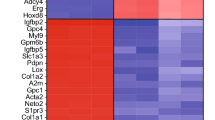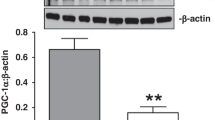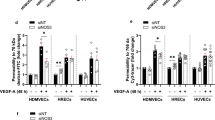Abstract
Permanent closure of the ductus arteriosus require loss of cells from the muscle media and development of neointimal mounds, composed in part of proliferating endothelial cells. We hypothesized that postnatal ductus constriction produces hypoxia of the inner vessel wall; we also hypothesized that hypoxia might lead to cell death and the production of vascular endothelial cell growth factor (VEGF), a hypoxia-inducible growth factor that stimulates endothelial proliferation. We mapped the distribution of hypoxia in newborn baboons and correlated it with the appearance of cell death (TUNEL technique), VEGF expression, and endothelial proliferation (proliferating cell nuclear antigen expression). In the full-term baboon (n = 10), the ductus was functionally closed on Doppler examination by 24 h after delivery. Regions of the ductus where the lumen was most constricted were associated with moderate/intense hypoxia; VEGF expression was increased in the hypoxic muscle media, and luminal endothelial cells, adjacent to the hypoxic media, were proliferating. Cells in the most hypoxic regions of the ductus wall were undergoing DNA fragmentation. In contrast, regions of the ductus with mild degrees of hypoxia had no evidence of cell death, VEGF expression, or endothelial proliferation. Cell death and endothelial proliferation seemed to be limited to regions of the full-term ductus experiencing moderate/intense hypoxia. In the premature baboon (67% gestation) (n = 24), only 29% closed their ductus by Doppler examination before d 6. None of the premature baboons, including those with a closed ductus by Doppler, had evidence of moderate/intense hypoxia; also, there was no evidence of cell death, VEGF expression, endothelial proliferation, or neointima formation by d 6. Therefore, the premature ductus is resistant to developing hypoxia, even when its lumen is constricted; this may make it susceptible to later reopening.
Similar content being viewed by others
Log in or create a free account to read this content
Gain free access to this article, as well as selected content from this journal and more on nature.com
or
Abbreviations
- EF5:
-
2-(2-nitro-1H-imidazol-1-yl)-N-(2,2,3,3,3-pentafluoroprophyl) acetamide
- PCNA:
-
proliferating cell nuclear antigen
- VEGF:
-
vascular endothelial cell growth factor
- TdT:
-
terminal deoxynucleotidyltransferase
References
Clyman RI, Mauray F, Roman C, Heymann MA, Payne B 1983 Factors determining the loss of ductus arteriosus responsiveness to prostaglandin E2. Circulation 68: 433–436.
Freed MD, Heymann MA, Lewis AB, Roehl SL, Kensey RC 1981 Prostaglandin E1 in infants with ductus arteriosus-dependent congenital heart disease. Circulation 64: 899–905.
Silove ED, Coe JY, Shiu MF, Brunt JD, Page AJ, Singh SP, Mitchell MD 1981 Oral prostaglandin E2 in ductus-dependent pulmonary circulation. Circulation 63: 682–688.
de Reeder EG, Girard N, Poelmann RE, Van Munsteren JC, Patterson DF, Gittenberger-De Groot AC 1988 Hyaluronic acid accumulation and endothelial cell detachment in intimal thickening of the vessel wall: the normal and genetically defective ductus arteriosus. Am J Pathol 132: 574–585.
Clyman RI, Goetzman BW, Chen YQ, Mauray F, Kramer RH, Pytela R, Schnapp LM 1996 Changes in endothelial cell and smooth muscle cell integrin expression during closure of the ductus arteriosus: an immunohistochemical comparison of the fetal, preterm newborn, and full-term newborn rhesus monkey ductus. Pediatr Res 40: 198–208.
de Reeder EG, Poelmann RE, van Munsteren JC, Patterson DF, Gittenberger-de-Groot AC 1989 Ultrastructural and immunohistochemical changes of the extracellular matrix during intimal cushion formation in the ductus arteriosus of the dog. Atherosclerosis 79: 29–40.
Tannenbaum JE, Waleh NS, Mauray F, Gold L, Perkett EA, Clyman RI 1996 Transforming growth factor- protein and messenger RNA expression is increased in the closing ductus arteriosus. Pediatr Res 39: 427–434.
Slomp J, van Munsteren JC, Poelmann RE, de Reeder EG, Bogers AJ, Gittenberger-de Groot AC 1992 Formation of intimal cushions in the ductus arteriosus as a model for vascular intimal thickening: an immunohistochemical study of changes in extracellular matrix components. Atherosclerosis 93: 25–39.
Weiss H, Cooper B, Brook M, Schlueter M, Clyman RI 1995 Factors determining reopening of the ductus arteriosus after successful clinical closure with indomethacin. J Pediatr 127: 466–471.
Gittenberger-de-Groot AC, Van Ertbruggen I, Moulaert AJMG, Harinck E 1980 The ductus arteriosus in the preterm infant: histologic and clinical observations. J Pediatr 96: 88–93.
Goldberg MA, Schneider TJ 1994 Similarities between the oxygen-sensing mechanisms regulating the expression of vascular endothelial growth factor and erythropoietin. J Biol Chem 269: 4355–4359.
Plate KH, Breier G, Millauer B, Ullrich A, Risau W 1993 Up-regulation of vascular endothelial growth factor and its cognate receptors in a rat glioma model of tumor angiogenesis. Cancer Res 53: 5822–5827.
Clyman RI, Waleh N, Black SM, Riemer RK, Mauray F, Chen YQ 1998 Regulation of ductus arteriosus patency by nitric oxide in fetal lambs: the role of gestation, oxygen tension and vasa vasorum. Pediatr Res 43: 633–644.
Kurki P, Ogata K, Tan EM 1988 Monoclonal antibodies to proliferating cell nuclear antigen (PCNA)/cyclin as probes for proliferating cells by immunofluorescence microscopy and flow cytometry. J Immunol Methods 109: 49–59.
Zeymer U, Fishbein MC, Forrester JS, Cercek B 1992 Proliferating cell nuclear antigen immunohistochemistry in rat aorta after balloon denudation: comparison with thymidine and bromodeoxyuridine labeling. Am J Pathol 141: 685–690.
Gordon D, Reidy MA, Benditt EP, Schwartz SM 1990 Cell proliferation in human coronary arteries. Proc Natl Acad Sci USA 87: 4600–4604.
Koch CJ, Evans SM, Lord EM 1995 Oxygen dependence of cellular uptake of EF5 [2-(2-nitro-1H-imidazol-1-yl)-N-( 2:2,3,3,3-pentafluoropropyl)acetamide]: analysis of drug adducts by fluorescent antibodies vs bound radioactivity. Br J Cancer 72: 869–874.
Evans SM, Joiner B, Jenkins WT, Laughlin KM, Lord EM, Koch CJ 1995 Identification of hypoxia in cells and tissues of epigastric 9L rat glioma using EF5 [2-(2-nitro-1H-imidazol-1-yl)-N-( 2:2,3,3,3-pentafluoropropyl) acetamide]. Br J Cancer 72: 875–882.
Lord EM, Harwell L, Koch CJ 1993 Detection of hypoxic cells by monoclonal antibody recognizing 2-nitroimidazole adducts. Cancer Res 53: 5721–5726.
Raleigh JA, Koch CJ 1990 Importance of thiols in the reductive binding of 2-nitroimidazoles to macromolecules. Biochem Pharmacol 40: 2457–2464.
Varghese AJ, Gulyas S, Mohindra JK 1976 Hypoxia-dependent reduction of 1-(2-nitro-1-imidazolyl)-3-methoxy-2-propanol by Chinese hamster ovary cells and KHT tumor cells in vitro and in vivo. Cancer Res 36: 3761–3765.
Laughlin KM, Evans SM, Jenkins WT, Tracy M, Chan CY, Lord EM, Koch CJ 1996 Biodistribution of the nitroimidazole EF5 (2-[2-nitro-1H-imidazol-1-yl]-N-(2:2,3,3,3-pentafluoropropyl) acetamide) in mice bearing subcutaneous EMT6 tumors. J Pharmacol Exp Ther 277: 1049–1057.
Gavrieli Y, Sherman Y, Ben-Sasson SA 1992 Identification of programmed cell death in situ via specific labeling of nuclear DNA fragmentation. J Cell Biol 119: 493–501.
Collins RJ, Harmon BV, Gobe GC, Kerr JF 1992 Internucleosomal DNA cleavage should not be the sole criterion for identifying apoptosis. Int J Radiat Biol 61: 451–453.
Niinikoski J, Heughan C, Hunt TK 1973 Oxygen tensions in the aortic wall of normal rabbits. Atherosclerosis 17: 353–359.
Heistad DD, Marcus ML 1979 Role of vasa vasorum in nourishment of the aorta. Blood Vessels 16: 225–238.
Lewis AB, Takahashi M, Lurie PR 1978 Administration of prostaglandin E1 in neonates with critical congenital cardiac defects. J Pediatr 93: 481–485.
Falanga V, Qian SW, Danielpour D, Katz MH, Roberts AB, Sporn MB 1991 Hypoxia upregulates the synthesis of TGF-beta 1 by human dermal fibroblasts. J Invest Dermatol 97: 634–637.
Klempt ND, Sirimanne E, Gunn AJ, Klempt M, Singh K, Williams C, Gluckman PD 1992 Hypoxia-ischemia induces transforming growth factor beta 1 mRNA in the infant rat brain. Brain Res Mol Brain Res 13: 93–101.
Pertovaara L, Kaipainen A, Mustonen T, Orpana A, Ferrara N, Saksela O, Alitalo K 1994 Vascular endothelial growth factor is induced in response to transforming growth factor-beta in fibroblastic and epithelial cells. J Biol Chem 269: 6271–6274.
Clyman RI, Campbell D, Heymann MA, Mauray F 1985 Persistent responsiveness of the neonatal ductus arteriosus in immature lambs: a possible cause for reopening of patent ductus arteriosus after indomethacin induced closure. Circulation 71: 141–145.
Clyman RI, Mauray F, Heymann MA, Roman C 1989 Influence of increased pulmonary vascular pressures on the closure of the ductus arteriosus in newborn lambs. Pediatr Res 25: 136–142.
Wolinsky H, Glagov S 1967 Nature of species differences in the medial distribution of aortic vasa vasorum in mammals. Circ Res 20: 409–421.
Barker SG, Talbert A, Cottam S, Baskerville PA, Martin JF 1993 Arterial intimal hyperplasia after occlusion of the adventitial vasa vasorum in the pig. Arterioscler Thromb 13: 70–77.
Zemplenyi T, Crawford DW, Cole MA 1989 Adaptation to arterial wall hypoxia demonstrated in vivo with oxygen microcathodes. Atherosclerosis 76: 173–179.
Paul RJ, Peterson JW 1975 Relation between length, isometric force, and O2 consumption rate in vascular smooth muscle. Am J Physiol 228: 915–922.
Clarke JA 1965 An x-ray microscopic study of the vasa vasorum of the human ductus arteriosus. J Anat 99: 527–537.
Ruffle TR, Olson EB, Graven SN, Zachman RD 1975 Oxygen consumption in fetal rabbit ductus arteriosus (38590). Proc Soc Exp Biol Med 148: 593–595.
Acknowledgements
The authors thank Mr. Paul Sagan for his expert editorial assistance, Ms. Vicki Winter and Ms. Linda Buchanan for their expert organizational skills, and Mr. Tim Jenkins for his help in the early stages of this project.
Author information
Authors and Affiliations
Additional information
This work was supported in part by U.S. Public Health Service National Heart, Lung, and Blood Institute Grants HL56061 and HL46691 and a gift from the Perinatal Associates Research Foundation. The BPD Resource Center is funded by NHLBI Grant HL52636. The Infant Star ventilators were provided, in part, by Infrasonics, Inc.
Rights and permissions
About this article
Cite this article
Clyman, R., Chan, C., Mauray, F. et al. Permanent Anatomic Closure of the Ductus Arteriosus in Newborn Baboons: The Roles of Postnatal Constriction, Hypoxia, and Gestation. Pediatr Res 45, 19–29 (1999). https://doi.org/10.1203/00006450-199901000-00005
Received:
Accepted:
Issue date:
DOI: https://doi.org/10.1203/00006450-199901000-00005
This article is cited by
-
Patent ductus arteriosus in preterm infants: is early transcatheter closure a paradigm shift?
Journal of Perinatology (2019)
-
Platelets contribute to postnatal occlusion of the ductus arteriosus
Nature Medicine (2010)
-
Effects of low oxygen saturation limits on the ductus arteriosus in extremely low birth weight infants
Journal of Perinatology (2009)
-
Delayed Closure of Ductus Arteriosus in Term Newborns with Congenital Hypothyroidism: Effect of l-Thyroxine Therapy
Pediatric Cardiology (2008)
-
Delayed Closure of the Ductus Arteriosus in Term Newborns with Congenital Hypothyroidism: Effect of l-Thyroxine Therapy
Pediatric Cardiology (2008)



